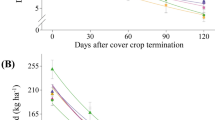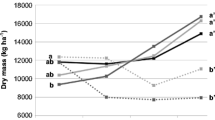Abstract
Forage legumes intercropped with grasses add nitrogen (N) to the production system and may increase forage yields. However, both phosphate fertilization and the solubility of phosphorus (P) sources may affect this contribution. This study aimed to evaluate the response of Guinea grass (Panicum maximum) intercropped with legumes and fertilized with phosphate fertilizers of different solubility. Guinea grass was grown as a single crop, fertilized or not with mineral N, and intercropped with Java (Macrotyloma axillare), or dwarf pigeon pea (Cajanus cajan); phosphorus was applied as triple superphosphate (P-TSP) or Bayóvar (P-Bay), plus a control without phosphorus. The highest forage yield and N accumulation was observed in Guinea grass fertilized with N and P, with 70,364 and 60,036 kg ha−1of dry matter, resulting in 977 and 1004 kg ha−1 of N accumulated by the plants for P-TSP and P-Bay, respectively. The introduction of legumes increased the N accumulation but decreased yield of Guinea grass. The highest nitrogen use efficiency (NUE) was found with P fertilization, i.e., 56% and 54% for P-TSP and P-Bay, respectively. The use of legumes intercropped with Guinea does not improve the effectiveness of the reactive rock phosphate. Therefore, the introduction of legumes intercropping with Guinea grass may be an alternative to N fertilization only when P is not applied to low fertile soils. Broadcast and incorporated P fertilization by the time of Guinea grass sowing, not only increases forage yields but also results in higher NUE regardless of P fertilizer solubility.





Similar content being viewed by others
References
Ae N, Arihara J, Okada K, Yoshihara T, Johansen C (1990) Phosphorus uptake by pigeon pea and its role in cropping systems of the Indian subcontinent. Science 248:477–480. https://doi.org/10.1126/science.248.4954.477
Akinnifesi FK, Makumba W, Sileshi G, Ajayi OC, Mweta D (2007) Synergistic effect of inorganic N and P fertilizers and organic inputs from Gliricidia sepium on productivity of intercropped maize in Southern Malawi. Plant Soil 294:203–217. https://doi.org/10.1007/s11104-007-9247-z
AOAC International (2006) Official methods of analysis of AOAC International, 19th edn. AOAC International, Arlington
Aulakh MS, Malhi SS (2005) Interactions of nitrogen with other nutrients and water: effect on crop yield and quality, nutrient use efficiency, carbon sequestration, and environmental pollution. Adv Agron 86:341–409. https://doi.org/10.1016/S0065-2113(05)86007-9
Barcellos AO, Ramos AKB, Vilela L, Martha GB Jr (2008) Sustainability of animal production based on intercropped pastures and use of exclusive legumes, as protein bank, in the Brazilian tropics. R Bras Zootec 37:51–67. https://doi.org/10.1590/S1516-35982008001300008(in Portuguese, with English abstract)
Braga GJ, de Mello ACL, Pedreira CGS, de Medeiros HR (2009) Photosynthesis and daily forage productivity of Tanzania Guinea grass pastures under rotational stocking. Pesq Agropec Bras 44:84–91. https://doi.org/10.1590/S0100-204X2009000100012
Cruz PA, Sinoquet H (1994) Competition for light and nitrogen during a regrowth cycle in a tropical forage mixture. Field Crops Res 36:21–30. https://doi.org/10.1016/0378-4290(94)90049-3
da Silva Patês NM, Pires AJV, da Silva CCF, Santos LC, de Carvalho GGP, Freire MAL (2007) Morphogenetic and structural characteristics of Tanzania Grass submitted to phosphorus and nitrogen rates. R Bras Zootec 36:1736–1741. https://doi.org/10.1590/S1516-35982007000800005(in Portuguese, with English abstract)
De Notaris C, Olesen JE, Sørensen P, Rasmussen J (2019) Input and mineralization of carbon and nitrogen in soil from legume-based cover crops. Nutr Cycl Agroecosyst 116(1):1–18. https://doi.org/10.1007/s10705-019-10026-z
Dias-Filho MB (1998) Pastagens cultivadas na Amazônia oriental brasileira: processos e causas de degradação e estratégias de recuperação. In: Dias LE, Mello JW (eds) Recuperação de áreas degradadas. UFV, Viçosa, pp 135–147 (in Portuguese)
Dias-Filho MB (2014) Diagnóstico das Pastagens no Brasil. Documentos Embrapa Amazônia Oriental, 402. Embrapa Amazônia Oriental, Brazil (in Portuguese). https://www.infoteca.cnptia.embrapa.br/bitstream/doc/986147/1/DOC402.pdf. Accessed 29 Sept 2019
Dwivedi BS, Shukla AK, Singh VK, Yadav RL (2003) Improving nitrogen and phosphorus use efficiencies through inclusion of forage cowpea in the rice-wheat systems in the Indo-Gangetic Plains of India. Field Crops Res 80:167–193. https://doi.org/10.1016/S0378-4290(03)00060-1
Fixen P, Brentrup F, Bruulsema T, Garcia F, Norton R, Zingore S (2015) Nutrient/fertilizer use efficiency: measurement, current situation and trends. In: Drechsel P, Heffer P, Magen H, Mikkelsen R, Wichelns D (eds) Managing water and fertilizer for sustainable agricultural intensification, 1st edn. IFA, IWMI, IPNI, IPI, Paris, France, pp 8–37
Garcia CMP, Costa C, de Meirelles PRL, Andreotti M, Pariz CM, Freitas LA, Teixeira Filho MCM (2016) Wet and dry corn yield under intercrop culivation with marandu grass and/or dwarf pigeon pea and nutritional value of the marandu grass in succession. Aust J Crop Sci 10:1564–1571. https://doi.org/10.21475/ajcs.2016.10.11.PNE183
Hassan HM, Marschner P, McNeill A, Tang C (2012) Growth, P uptake in grain legumes and changes in rhizosphere soil P pools. Biol Fert Soils 48:151–159. https://doi.org/10.1007/s00374-011-0612-y
Haystead A, Malajczuk N, Grove TS (1988) Underground transfer of nitrogen between pasture plants infected with VA mycorrhizal fungi. New Phytol 108:417–423
Hinsinger P, Betencourt E, Bernard L, Brauman A, Plassard C, Shen J, Tang X, Zhang F (2011) P for two, sharing a scarce resource: soil phosphorus acquisition in the rhizosphere of intercropped species. Plant Physiol 156:1078–1086 10.1104/pp.111.175331
Houlton BZ, Wang YP, Vitousek PM, Field CB (2008) A unifying framework for dinitrogen fixation in the terrestrial biosphere. Nature 454:327–330. https://doi.org/10.1038/nature07028
Howarth RW, Boyer EW, Pabich WJ, Galloway JN (2002) Nitrogen use in the United States form 1961-2000 and potential future trends. Ambio 31:88–96. https://doi.org/10.1579/0044-7447-31.2.88
IBGE - Instituto Brasileiro de Geografia e Estatística (2017). Cattle herd records greatest increase in time series. IBGE News Agency. https://agenciadenoticias.ibge.gov.br/agencia-noticias/2012-agencia-de-noticias/noticias/16994-rebanho-de-bovinos-tem-maior-expansao-da-serie-hist%C3%B3rica. Accessed 20 Aug 2018
Iqbal MA, Hamid A, Ahmad T, Siddiqui MH, Hussain I, Ali S, Ali A, Ahmad Z (2019) Forage sorghum-legumes intercropping: effect on growth, yields, nutritional quality and economic returns. Bragantia 78:82–95. https://doi.org/10.1590/1678-4499.2017363
Janzen HH, Beauchemin KA, Bruinsma Y, Cambell CA, Desjardins RL, Ellert BH, Smith EG (2003) The fate of nitrogen in agroecosystems: an illustration using Canadian estimates. Nutr Cycl Agroecosyst 67:85–102. https://doi.org/10.1023/A:1025195826663
Ladha JK, Pathak H, Krupnick TJ, Six J, van Kessel C (2005) Efficiency of fertilizer nitrogen in cereal production: retrospects and prospects. Adv Agron 87:85–156. https://doi.org/10.1016/S0065-2113(05)87003-8
Léon LA, Fenster WE, Hammond LL (1986) Agronomic potencial of eleven phosphate rocks from Brazil, Colombia, Perú and Venezuela. Soil Sci Soc Am J 50:798–802. https://doi.org/10.2136/sssaj1986.03615995005000030046x
Merlin A, He ZL, Rosolem CA (2013) Ruzigrass affecting soil–phosphorus availability. Pesq Agropec Bras 48:1583–1588. https://doi.org/10.1590/S0100-204X2013001200007
Miranda CBH, Fernandes CD, Cadish G (1999) Quantifying the nitrogen fixed by Stylosanthes. Pasturas Tropicales 21:64–69 (in Spanish)
Narwal SS (1998) Allelopathic interactions in multiple cropping systems. In: Narwal SS, Hoagland RE, Dilday RH, Reigosa MJ (eds). allelopathy in ecological agriculture and forestry proceedings of the III international congress on allelopathy in ecological agriculture and forestry, Dharwad, India, 18–21 August 1998, pp 141–157
Novais RF, Smyth TJ (1999) Phosphorus in soil and plant in tropical conditions. UFV, Viçosa, MG, Brazil (in Portuguese)
Novais RF, Smyth TJ, Nunes FN (2007) Phosphorus. In: Novais RF, Alvarez VH et al (eds) Soil fertility. Sociedade Brasileira de Ciência do Solo Fertilidade do Solo/Universidade Federal de Viçosa, Viçosa, MG, Brazil, pp 471–537
Nuruzzaman M, Lambers H, Bolland MDA, Veneklaas EJ (2005) Phosphorus benefits of different legume crops to subsequent wheat grown in different soils of Western Australia. Plant Soil 271:175–187. https://doi.org/10.1007/s11104-004-2386-6
Olibone D, Rosolem CA (2010) Phosphate fertilization and phosphorus forms in an Oxisol under no-till. Sci Agric 67:465–471. https://doi.org/10.1590/S0103-90162010000400014
Pavinato OS, Rosolem CA (2008) Effects of organic compounds produced by plants on soil nutrient availability. R Bras Ci Solo 32:911–920. https://doi.org/10.1590/S0100-06832008000300001
Peoples MB, Craswell ET (1992) Biological nitrogen fixation: investments, expectations and actual contributions to agriculture. Plant Soil 141:13–39
Peron AJ, Evangelista AR (2004) Pasture degradation in Savanna’s regions. Ciênc Agrotec 28:655–661. https://doi.org/10.1590/S1413-70542004000300023(in Portuguese, with English abstract)
Raynaud X, Jaillard B, Leadley PW (2008) Plants may alter competition by modifying nutrient bioavailability in rhizosphere: a modeling approach. Am Nat 171:44–58. https://doi.org/10.1086/523951
Rietra RPJJ, Heinen M, Dimkpa CO, Bindraban PS (2017) Effects of Nutrient Antagonism And Synergism On Yield And Fertilizer Use Efficiency. Commun Soil Sci Plant Anal 48:1895–1920. https://doi.org/10.1080/00103624.2017.1407429
Rose TJ, Kearney LJ, Erler DV, van Zwieten L (2019) Integration and potential nitrogen contributions of green manure inter-row legumes in coppiced tree cropping systems. Eur J Agron 103:47–53. https://doi.org/10.1016/j.eja.2018.11.008
Rosolem CA, Ritz K, Cantarella H, Galdos MV, Hawkesford MJ, Whalley WR, Mooney SJ (2017) Enhanced plant rooting and crop system management for improved N use efficiency. Adv Agron 146:205–239. https://doi.org/10.1016/bs.agron.2017.07.002
Rütting T, Aronsson H, Delin S (2018) Efficient use of nitrogen in agriculture. Nutr Cycl Agroecosyst 110:1–5. https://doi.org/10.1007/s10705-017-9900-8
Sheldrick WF, Syers JK, Lindgard J (2002) A conceptual model for conducting nutrient audits at the national, regional, and global scales. Nutr Cycl Agroecosyst 62:61–72. https://doi.org/10.1023/A:1015124930280
Soil Survey Staff (2014) Keys to soil taxonomy, 12th edn. USDA-Natural Resources Conservation Service, Washington, DC
Sousa DMG, Lobato E, Rein TA (2004) Fertilization with phosphorus. In: Sousa DMG, Lobato E (eds) Cerrado: Soil amendments and fertilization, 2nd edn. Embrapa Cerrados, Planaltina, DF, Brazil, pp 147–168
Subbarao GV, Ae N, Otani T (1997) Genotypic variation in iron-, and aluminum-phosphate solubilizing activity of pigeonpea root exudates under P deficient conditions. Soil Sci. Plant Nutr 43:295–305. https://doi.org/10.1080/00380768.1997.10414754
Sutton MA, Bleeker A, Howard CM, Bekunda M et al. (2013) Our nutrient world: the challenge to produce more food and energy with less pollution. Global overview of nutrient management. Centre for Ecology and Hydrology, Edinburgh on behalf of the Global Partnership on Nutrient Management and the international nitrogen initiative. https://nora.nerc.ac.uk/id/eprint/500700/1/N500700BK.pdf. Accessed 29 Sept 2019
Teixeira SO, Teixeira RO, dos Santos VB, de Carvalho MAC, Yamashita OM (2018) Phosphorus and nitrogen doses in the production of Brachiaria híbrida cv. Mulato II. Ceres 65:28–34. https://doi.org/10.1590/0034-737X20186501000510.1590/0034-737X201865010005
Van Raij B, Andrade JC, Cantarella H, Quaggio JA (2001) Análise química para avaliação da fertilidade de solos tropicais. IAC, Campinas, Brazil
Venterink HO (2011) Legumes have a higher rootphosphatase activity than other forbs, particularly under lowinorganic P and N supply. Plant Soil 347:137–146 10.1007/s11104-011-0834-7
Wang Y, Marschner P, Zhang F (2012) Phosphorus pools and other soil properties in the rhizosphere of wheat and legumes growing in three soils in monoculture or as a mixture of wheat and legume. Plant Soil 354:283–298. https://doi.org/10.1007/s11104-011-1065-7
Xiong LM, Zhou ZG, Fardeau JC, Feng GL, Lu RK (2002) Isotopic assessment of soil phosphorus fertility and evaluation of rock phosphates as phosphorus sources for plants in subtropical China. Nutr Cycl Agroecosyst 63:91–98. https://doi.org/10.1023/A:102050100
Zhang F, Shen J, Zhang J, Zuo Y, Li L, Chen X (2010) Rhizosphere processes and management for improving nutrient use efficiency and crop productivity: implications for China. Adv Agron 107:1–28. https://doi.org/10.1016/S0065-2113(10)07001-X
Acknowledgements
This work was undertaken as part of NUCLEUS: a virtual joint center to deliver enhanced NUE via an integrated soil–plant systems approach for the United Kingdom and Brazil. Funded in Brazil by FAPESP—São Paulo Research Foundation [Grant 2015/50305-8], FAPEG—Goiás Research Foundation [Grant 2015-10267001479], and FAPEMA—Maranhão Research Foundation [Grant RCUK-02771/16]; and in the United Kingdom by BBSRC/Newton Fund [BB/N013201/1]. The authors would like to thank the Agrisus Foundation – Sustainable Agriculture (Proc. PA 1316/14) for providing financial support, and the National Council for Scientific and Technological Development (CNPq) for granting an award for excellence in research to the second and fourth authors. Jim Hesson revised the manuscript (Academic English Solutions)
Author information
Authors and Affiliations
Corresponding author
Additional information
Publisher's Note
Springer Nature remains neutral with regard to jurisdictional claims in published maps and institutional affiliations.
Electronic supplementary material
Below is the link to the electronic supplementary material.
Rights and permissions
About this article
Cite this article
Francisquini Junior, A., Calonego, J.C., Rosolem, C.A. et al. Increase of nitrogen-use efficiency by phosphorus fertilization in grass–legume pastures. Nutr Cycl Agroecosyst 118, 165–175 (2020). https://doi.org/10.1007/s10705-020-10091-9
Received:
Accepted:
Published:
Issue Date:
DOI: https://doi.org/10.1007/s10705-020-10091-9




